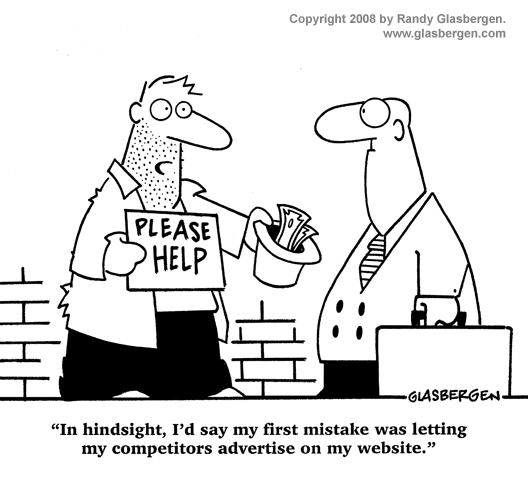6 Traffic Generation Habits You Should Stop
6 Traffic Generation Habits You Should Stop
Traffic generation is the holy grail of online marketing. Website traffic has been cited as the most effective content marketing metric, which is why brands must understand how to drive traffic without compromising quality of content. Unfortunately, as traffic generation and SEO have changed over the years, many mistakes continue to be made. As a result, many seemingly well-established SEO practices can greatly damage your brand’s credibility and harm your website traffic.
Here are six traffic generation practices you should avoid at all costs:
1. Stuffing content with keywords
Stuffing your content with keywords can drastically hurt your website traffic. Whether it is adding high volume of keywords or irrelevant phrases and words, these are harmful SEO practices that can cause irreparable damage to your traffic generation efforts. Doing so will attract Google penalties like marking your site as spam or lower your page ranking. It will also hurt your brand image because customers will feel betrayed by your use of misleading information.
Rather than stuff your content with many or irrelevant keywords, writing high quality content should be your goal. Remember, people don’t just come to your site just for the sake of it; they are looking for valuable resources and answers to their problems. One way to find out what your readers are looking for is to think about the questions your readers type into Google search and use those questions to create powerful content that will provide the answers. You can also visit platforms like Reddit and Quora to find out what people are discussing. This will help you determine the right keywords to use. Whatever the case, concentrate on writing high quality content.
2. Building as many backlinks as possible
When it comes to backlinks, it’s all about quality over quantity. Many people think that having thousands of links pointing to their website is the smartest traffic generation tactic. However, this practice can actually be detrimental to your SEO. It is better to have a dozen of quality backlinks instead of having thousands of spam links. Use tools like Buzzsumo to determine which backlinks are top quality in your industry. For instance, if you own a blog about entrepreneurship, your best bet for backlinks should come from sites like Entrepreneur, Fortune, Bizify, Quora and Inc, among others. By all means, avoid buying backlinks if you don’t want to land in trouble with Google.
3. Focusing only on page rankings
Page ranking is an important factor when it comes to making it to the top of Google’s search results. However, one should not put all eggs in one basket. Many elements contribute to page ranking. According to a 2015 study by Moz, 88% of marketers believe mobile-friendliness will influence page rankings. 81% believe that the perceived value of the website by the visitors also plays a critical role. Other factors that influence page rankings are speed of website and the quality and quantity of instant answers provided in SERPs. Therefore, instead of worrying about whether your website is ranked at the top, you need to look at different strategies that can drive results for your brand. For instance, you can produce more mobile optimized landing pages and produce quality content that provide instant answers in the SERPs. By taking care of these individual strategies, you will be able to tweak your website so that it appears in top results.
4. Writing low-value content
Gone are the days when quantity of content was the determining factor in driving traffic. Today, marketers are more concerned about producing quality content that provide value to the users. In fact, Google introduced an algorithm that penalizes sites that produce low-quality content. In that regards, any content you produce should provide value to the readers. That is to say quality content should be your most valuable SEO tactic. There are a number of elements you need to take into consideration when implementing your content creation strategy. The first element is your audience. Understanding your audience is crucial. Are your visitors male or female? What is their geographical locations? What is their age group? Do your visitors come to amuse themselves or to learn serious stuff? Understanding your audience will help you to structure your content according to their needs.
5. Duplicating content on different websites
Writing content and then duplicating it to different sites as guest post is definitely going to hurt your ranking. Although Google can differentiate between the first publisher of content and republished content, content duplications brings more harm than good. It might succeed in increase in the number of back links but it can also become difficult to know monitor the changes to your content. Your brand’s image also suffers in the process. So the only solution is to write original content and share it is social media. If you want to publish guest posts or syndicate your content, please write fresh content for every website you want to publish your content.
6. Including complex coding on your website and installing too many widgets
Widgets, tools, analytic software, surveys, forms etc can be great tools for any website; however, too much of something is bad. Having too many widgets and tools coupled with complex coding can slow down your website yet people expect a website to load in less than 2 seconds. This is likely to be the reason you are performing poorly in traffic generation department. The average user has no patience for a page that takes ages to load. Slow speeds in websites results to high bounce rates, a factor used by Google to rank websites.
Increase Your Landing Page Conversion Using These 7 Steps
Increase Your Landing Page Conversion Using These 7 Steps
Your company’s website is arguably your most important marketing asset, and landing pages are the perfect gateways to your website. Unfortunately, most companies struggle to achieve decent conversion rates. According to Digital Doughnut, only 22% of marketers are satisfied with their landing page conversion rates.
If your landing page format isn’t right or your offerings and visuals aren’t offering visitors what they are looking for, then you might not be successful when it comes to lead generation.
In order to boost your landing page conversion rates, you will first need to know where you are and what you need to improve on your conversion rates. Here is a 7-step process to increase your landing page conversion rates.
1. What is your campaign goal?
If your landing page lack focus and a clear goal, it would be difficult to achieve your targets. Your landing page should only have one goal or objective in order to avoid confusing your users. For instance, do not offer multiple offers that will make your prospects lose sight of what to do next. If you focus on only one solution or offer, your users will net get confused. If your sole purpose is to capture email addresses, do not introduce other CTAs like “BUY NOW”.
2. Are your headlines simple and straightforward?
You only have a small window of opportunity to impress your users. Actually, you have less than 7 seconds to grab the attention of your visitor; so, having headlines that are not only simple, but also bold and straightforward helps a great deal. Actually, the first thing your visitor should see in your headline is the exact solution or offer you advertised. In other words, the keyword in your ad should appear in the headline. This serves two purposes: to reassure your visitors that they have come to the right place as well as to help your quality score.
3. Never trick your customers
The surest way to dramatically reduce your landing page conversions and ruin your reputation forever is to trick your prospects. When someone clicks on your ad, they expect to be taken directly to whatever they are looking for. Give them what they came for.
4. Use simple Call-to-action buttons
There is a difference between knowing what you want your visitors to do when they land on your page and those visitors actually knowing that. Use clear Call-to-Action buttons to reduce the amount of friction to the action you want your visitors to take. It is important to ensure that your CTAs are displayed prominently on your landing page. You will need to do many tests to determine the right shape, size, text and color to use on your landing page.
5. Is your text compelling enough?
Your landing page text (copy) should be compelling enough to lure your prospects to take action. You must have a clear flow of information to convince your customers to subscribe, open their wallets or download your offers. It also helps to have a FAQ section to address concerns that your users might have.
6. Use the right images
They say a picture speaks a thousand words. You need appropriate images to arouse the emotions of your prospects and drive your point home. Make sure that all the images on your landing page are in sync with the message of your content. The best content paired with the right image can result in higher conversion rates.
7. Optimize for mobile
You could lose many prospects if your landing page is not optimized for mobile viewing. According to a study by Smart Insights, 80% of internet users have and use their smartphones to access the internet. Formstack also found out that you sites that are not mobile optimized lose 57% of referral traffic. This is by no means insignificant. The best thing you can do is to optimize your landing page for mobile devices.
Landing page conversion optimization is not an easy task. It requires one to be patient, open-minded and observant. As there is no one-size-fits-all formula for increasing conversions, you should continuously test your landing page elements such as CTA buttons, text, images etc to find the right combination.
-MJRvisuals
4 Clever Advertising Techniques You Should Be Using Today
4 Clever Advertising Techniques You Should Be Using Today
Companies are spending thousands of dollars every year on advertising. The big boys even spend hundreds of thousands or millions in print and paid click advertisements. Unfortunately, that also means we get to be bombarded with endless amount ads that lie, that are lazily designed or misplaced. So how do you stay clear of lousy advertising?
Here are there techniques you can use to create amazing ads that resonate with people.
Design Clever ads
There is a whole lot of difference between funny advertisements and effective ads that accomplish their jobs. When designing your ad, make sure that it is able to clearly deliver its message and make people enjoy it at the same time. It should not just be funny for the sake of it. In fact, you do not design an ad so that it is funny. You design an ad that people will be able to connect with.
Insightful
Your ad’s potential impact will be determined by how insightful it is. Does it make the audience think about their beliefs and actions? Does it result in that Eureka Moment? If you achieve this, you will do much better than your competition.
Feeling
Try to connect with your audience emotionally. As Maya Angelou once said, people will forget what you did or said, but they will never forget how you made them feel. You may spend a lot of time convincing your prospects to buy from you; you may even offer very competitive prices, but if you are not connecting with them emotionally, you are not going to create much impact. The fact of the matter is that people are not always rational when making buying decisions. Their emotions usually get the better of them.
Trustworthiness
People buy from companies they like. People will like you if they also trust in you. You see, it is impossible for people to like you if they don’t trust you. Every character you select to appear in your ad should sound and look trustworthy. Every message you deliver should be factual.
Whatever your advertisement goal is, whichever industry you are and now matter your size, it is important to advertise wisely. If you need help, seek the advice or services of a professional advertising agency.
MJRvisuals is a Creative Agency specializing in visual imagery and digital marketing.
MJRvisuals - Imagination Defined
Struggling in search? info from a media solutions company.
Struggling in search? Gone are the times when search results didn’t affect your business. If you’re still thinking this way, it’s time to redirect your focus. Search results have an impact on your bottom line.
Luckily, search engine optimization tactics are available to improve your presence in search results. Google even gives out a great starter guide for anyone wanting to learn.
There are two main areas you will want to start with when optimizing for search engines - your business listings and your website. These are the typically the areas with the most problems and also have a big impact on your search presence. Here are a few tips to help improve your search presence in these areas.
Check your business listings. Have you listed or claimed and verified your business on Google? Do you have a business listing on Bing Places, Yelp, Yahoo! or YP? Do you have social media profiles? If you don’t have all of these, you have some work to do. Not only that, you need to make sure your business’ name, address, phone number and URL are all consistent. Fill out each listing to 100% complete, name your files with your business’ name, location and services, and make sure to select the right categories. Many of these sites are interconnected, so you are sending information to more than one business listing directory. Make sure it’s right.
Tip: Don’t spend any money with any business listings. You can find a plethora of business listing directories that don’t charge you anything. Excluding social media profiles, Bing and Google, I don’t recommend advertising with any of these business listing directories, either.
Next, check your website. Do you have any broken links? Do you have an XML Sitemap? Have you filled out and optimized the meta information on all of your site’s pages? Are you pages filled with content? Ask your web developer to check and fix any broken links on your website. If you use a Wordpress website, remember, when you change a URL on an already published page, you have to create a 301 redirect, or it will be a broken link, which search engines don’t like. Follow Google’s guidelines for creating an XML Sitemap and submit it in Webmaster Tools. Fill out and optimize your meta information on your website. Use Google’s Keyword Planner Tool to guide which keyword you should optimize for and include the location in which your business operates and services. Lastly, content on your site should be flowing at all times. Through a blog, updates, social feeds, etc. Get used to being a publisher, because the best brands are becoming so. Make sure your pages have lots of content, provide great direction for your visitors, and speak customer service.
Before sending users to your site, search engines want to know that your website will provide an optimal experience for the searcher. Tactics such as building an XML sitemap, filling out meta information, and having a presence on major business listing sites and social media, help by providing a trustworthy and consistent data and information for Google to store in its database to remember about your business the next time someone is searching for a business like yours.
Once you get the basics down, the next key is to get social, on social media, and always keep your website, social media profiles, business listings and everything else fresh and updated. If you are actively taking care of your search presence, your search results will improve and so will your profits. Investing time in your organic search presence will last longer and reap many rewards. The key is to stay patient.
To partner with MJR Visuals for your next video project, send us a message through our contact form.
Media Solution Company Company talks about Struggling in search
Media Solution Company Company talks about Struggling in search? Gone are the times when search results didn’t affect your business. If you’re still thinking this way, it’s time to redirect your focus. Search results have an impact on your bottom line.
Luckily, search engine optimization tactics are available to improve your presence in search results. Google even gives out a great starter guide for anyone wanting to learn.
There are two main areas you will want to start with when optimizing for search engines - your business listings and your website. These are the typically the areas with the most problems and also have a big impact on your search presence. Here are a few tips to help improve your search presence in these areas.
Check your business listings. Have you listed or claimed and verified your business on Google? Do you have a business listing on Bing Places, Yelp, Yahoo! or YP? Do you have social media profiles? If you don’t have all of these, you have some work to do. Not only that, you need to make sure your business’ name, address, phone number and URL are all consistent. Fill out each listing to 100% complete, name your files with your business’ name, location and services, and make sure to select the right categories. Many of these sites are interconnected, so you are sending information to more than one business listing directory. Make sure it’s right.
Tip: Don’t spend any money with any business listings. You can find a plethora of business listing directories that don’t charge you anything. Excluding social media profiles, Bing and Google, I don’t recommend advertising with any of these business listing directories, either.
Next, check your website. Do you have any broken links? Do you have an XML Sitemap? Have you filled out and optimized the meta information on all of your site’s pages? Are you pages filled with content? Ask your web developer to check and fix any broken links on your website. If you use a Wordpress website, remember, when you change a URL on an already published page, you have to create a 301 redirect, or it will be a broken link, which search engines don’t like. Follow Google’s guidelines for creating an XML Sitemap and submit it in Webmaster Tools. Fill out and optimize your meta information on your website. Use Google’s Keyword Planner Tool to guide which keyword you should optimize for and include the location in which your business operates and services. Lastly, content on your site should be flowing at all times. Through a blog, updates, social feeds, etc. Get used to being a publisher, because the best brands are becoming so. Make sure your pages have lots of content, provide great direction for your visitors, and speak customer service.
Before sending users to your site, search engines want to know that your website will provide an optimal experience for the searcher. Tactics such as building an XML sitemap, filling out meta information, and having a presence on major business listing sites and social media, help by providing a trustworthy and consistent data and information for Google to store in its database to remember about your business the next time someone is searching for a business like yours.
Once you get the basics down, the next key is to get social, on social media, and always keep your website, social media profiles, business listings and everything else fresh and updated. If you are actively taking care of your search presence, your search results will improve and so will your profits. Investing time in your organic search presence will last longer and reap many rewards. The key is to stay patient.
To partner with MJRVisuals for your next video project, send us a message through our contact form.
You’re Engaged! Now What? From a Video Production Company
You’re Engaged! Now What? From a Video Production Company; You just got engaged, and it’s the most exciting time of your life. You are nervous, thrilled and slightly panicked. Why? You know your next steps are planning your wedding, and it’s not going to stop until the wedding.
If you’re just now getting engaged, it’s likely that you’ve never planned a wedding before. To save your energy and time, it’s important to take certain steps first. Here’s what you should be focusing on when you first start planning your wedding.
- Plan your budget. Figure out who’s paying for what, and how much money will be allocated to each area.
- Start building your guest list and approximate your cost, based on your initial list.
- Try to settle on 2 or 3 dates, and start researching venues. The earlier you book your venues, the better.
- Start building your wedding website. Check out the Knot, Wedding Wire, and eWedding, to name a few.
- Select your wedding party.
- Organize and plan using Pinterest boards.
Start with these 7 steps, and you are building a great foundation for stress-free wedding planning. Check back for part two to find out what’s next.
When it comes to keeping your wedding day living on forever, Wedding Videography by MJR Visuals is here to help. Contact us today to learn more!
Pinterest and video production for your business
 Pinterest and video production for your business ; Pinterest has become a great resource for many women, and has even grown popular to men. It is visual, making it enjoyable to navigate. It has extensive search filters, making it easy to navigate, and it provides a place to save links and ideas for later use and conveniences.
Pinterest and video production for your business ; Pinterest has become a great resource for many women, and has even grown popular to men. It is visual, making it enjoyable to navigate. It has extensive search filters, making it easy to navigate, and it provides a place to save links and ideas for later use and conveniences.
Luckily, there is room for businesses in the action. Pinterest users don’t mind product promotions, enjoy reading blog posts and want to connect with their favorite companies.
Wal-Mart has 38,278 followers. Target has almost 450,000 followers. If these statistics don’t get you excited for opportunities on Pinterest, I don’t know what will!
Pinterest is another way to reach your potential customers and can be a great resource for growing your business.Here are 8 tips to get your business started on Pinterest.
- Add a Pinterest social media icon to your website, so your customers can quickly access your profile.
- Add Pin It buttons to your website, so your visitors can easily pin content and link back to your site. The directions to install are on Pinterest and are very easy to follow.
- Add a Pinterest widget or feed to your website. This way, your visitors can see your latest activity.
- Verify your website on Pinterest Analytics to get the numbers on the performance and popularity of your pins.
- Try to create images with a 2:3 ratio. These are proven to perform better.
- Get a basic understanding of the categories and keywords that Pinterest users will be using when looking for your pins and consistently optimize each of your pins for them.
- Start engaging with others by tagging your followers, following users who like pages like yours, and inviting your other social media followers to join you on Pinterest.
- Don’t just wing it -- have a strategy. Set goals, create a schedule and be interactive.
MJR Visuals is good for not only providing online marketing tips, but engaging your potential customers through video marketing. Click Here to Contact us today!






